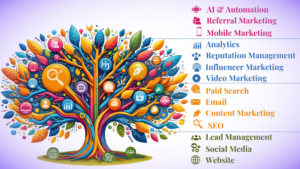 User experience (UX) is crucial to your digital marketing efforts. However, nearly half of all businesses don’t engage in any online UX testing per Skyhook research. This may be because it’s rarely talked about outside of website design and development circles, but it’s one of the first things I address when I take on a new project as a digital marketing consultant.
User experience (UX) is crucial to your digital marketing efforts. However, nearly half of all businesses don’t engage in any online UX testing per Skyhook research. This may be because it’s rarely talked about outside of website design and development circles, but it’s one of the first things I address when I take on a new project as a digital marketing consultant.
Give me a few minutes and I’ll explain why, then walk you through the basics so you can improve your UX immediately.
What is User Experience?
User experience, often shortened to UX, is all about website usability and how people interact with your website or application. In short, it can be thought of as how easy to use and helpful your website is.
In terms of website design, UX is sometimes confused or intermingled with UI, which is short for user interface. Whereas UX deals more with tangible usability, UI is more about aesthetic appeal. For example, a UX designer will focus on how intuitive a menu is and if users will easily find the information they want. A UI designer will be more concerned about typography and colors.
Although they’re different subsets of development, both impact the end-user experience, so we’ll explore how both influence your digital marketing success here.
Elements of Strong User Experience
- Usability: Website navigation should be intuitive and anticipate what a visitor is looking for before they land on the page.
- Functionality: Websites that deliver a strong user experience are free of fluff so that visitors can engage easily. Speed is essential too.
- Responsive: More than half of all website traffic comes from mobile devices, according to Google. Visitors should have the same experience regardless of their device or browser.
- Navigation: Visitors should be able to find the information they’re looking for with minimal clicks.
- Design: Modern consumers prefer a clean interface, though the content should still get their attention and convey the value of your products or services.
Why User Experience is So Important for Digital Marketers
We’ve all likely seen the standard digital marketing funnel by now. It shows the pathway people follow on the way to becoming customers. Generally speaking, it includes:
- Discovery
- Interest
- Appraisal/ Consideration
- Confirmation
- Conversion
People typically follow a variant of this path. If anything stops them along the way, they don’t become customers. This is where UX comes in.
More than half of all mobile visitors will leave a site if it takes more than three seconds to load, according to Google. In this case, you will lose your prospect as early as the Discovery or Interest phase. Furthermore, around eight in ten will immediately look for a new site if they don’t like what they see on the first site they visit, per TrueList. Their research shows nine in ten won’t return to a site solely because they feel the UX is bad. So again, you lose them at the Discovery or Interest phase if your UX isn’t up to par.
You can also lose prospects at the Appraisal and Confirmation stages if your UX isn’t top-notch. Three-quarters of customers judge your business’s credibility based on your website, according to YouGov. Their research shows that 94 percent won’t trust you if your website is outdated.
Getting them to the conversion stage doesn’t necessarily guarantee they’ll actually convert either. Mobile users, for example, are five times more likely to abandon their tasks if the site is not optimized for mobile per TrueList. Their research concludes that just a one-second delay in your page load time reduces conversions by seven percent as well.
We can look at the inverse too. For example, improving your customer journey can increase customer satisfaction by 20 percent, boost revenue by 15 percent, and reduce the cost of serving customers by up to 20 percent, according to McKinsey.
How Improving User Experience Impacts Digital Marketing

Any way you look at it, improving your user experience is good for your digital marketing, and that which improves your marketing is good for your business. Let’s look at the mechanics behind why it works.
Positive UX Improves Your Customer Satisfaction
Have you ever had a frustrating experience with a website? Maybe you couldn’t find what you were looking for, the site didn’t load, or a feature wasn’t working properly. It’s easy to see how the opposite is true as well. People are simply happier when a site delivers on their expectations.
Good User Experience Improves Your SEO
There is a multitude of factors that impact your search engine optimization (SEO) and how your site ranks on search engines like Google. Four of the top seven ranking factors are actually aspects of UX, according to Search Engine Journal. These include:
- High-Quality Content
- Mobile Usability
- Page Experience
- Page Speed
In other words, focusing on UX can help your business appear in more searches, appear closer to the top of searches, and attract more visitors.
Your User Experience Can Help Build Conversions
A good user interface can increase conversion rates by up to 200 percent, according to TrueList. That makes sense considering all the ways your UX can stall out a prospect as they move through the funnel. When your UX is strong, people move through the funnel fluidly. The site behaves how they expect, they find what they want, trust is built, and they ultimately convert.
A Strong User Experience Boosts Revenue
Conversion rates correlate with revenue hikes for your business, so you’ll naturally boost revenue as your conversions climb. In addition, eight in ten internet users say they’re willing to pay extra for a good user experience per TrueList research. People are willing to pay more for simplicity, and it shows when your sales numbers come in.
A Strong User Experience Strategy Improves Your ROI
Your business should be getting a solid return on investment (ROI) for its marketing initiatives. However, it’s hard to hit your mark if you’re not getting the conversions you need or aren’t closing high-value sales. A strong UX addresses this, so you naturally see greater ROI too.
How Digital Marketing Can Influence User Experience
You’ve now learned why UX is important to the success of your digital marketing. However, it’s important to note that the two go together. Your digital marketing impacts the end-user experience too.
For example, the images you select and the content your digital marketing team creates can make or break an experience for a visitor. Is the person finding what they expect? Is the content helpful?
Another example is landing pages. Marketing teams often build specialized pages on the fly to accompany their campaigns. Even though these are not part of the primary website, the way they’re built, how they function, and whether they work properly on mobile devices impact the user experience.
If your marketing team isn’t nailing UX, you’re not just missing out on the leads they could be generating. You could be sabotaging your own SEO, which means you’re robbing yourself of leads you would have otherwise attracted if they hadn’t done anything.
Get Help Improving Your User Experience
What I’ve said on this page might sound dramatic or even unpopular, but it’s why I firmly believe that UX should be part of your digital marketing efforts. You’ll get better digital marketing results if both work together.
As a digital marketing consultant with decades of experience, I’ve helped Fortune 100 companies, multinational corporations, and even small businesses amplify their digital marketing results by enhancing the UX. If you think your UX is lacking or you aren’t getting ROI from your digital marketing initiatives, contact me for a complimentary consultation.




































































